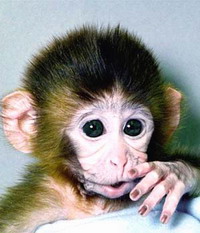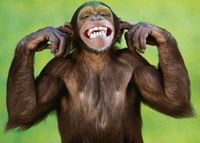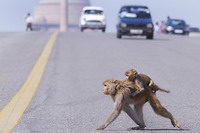Login form
Monkey
 Monkey (animal), any of about 160 species of primates that have grasping hands, forward-facing eyes, and highly developed brains. Most monkeys also have tails, a characteristic that distinguishes them from their larger primate cousins, the apes. Monkeys are highly skilled climbers, and most spend much of their lives in trees. Some have prehensile tails—that is, tails capable of grasping—that they can use as a fifth limb while foraging for food or climbing.
Monkey (animal), any of about 160 species of primates that have grasping hands, forward-facing eyes, and highly developed brains. Most monkeys also have tails, a characteristic that distinguishes them from their larger primate cousins, the apes. Monkeys are highly skilled climbers, and most spend much of their lives in trees. Some have prehensile tails—that is, tails capable of grasping—that they can use as a fifth limb while foraging for food or climbing.
Zoologists classify monkeys into three distinct families: marmosets, Capuchin-like monkeys, and Old World monkeys. Marmosets and Capuchin-like monkeys are found only in Central and South America and are known collectively as New World monkeys.
Marmosets are dainty animals with luxurious fur, which is sometimes strikingly colored. One species, the pygmy marmoset, is the world's smallest monkey, measuring just 30 cm (12 in) long, at least half of which is tail, and weighing as little as 113 g (4 oz) when fully grown.
The average life span of a pygmy marmoset in the wild is 10 to 12 years. By comparison, the Capuchin-like monkeys, which include capuchin monkeys, douroucoulis, spider monkeys, woolly monkeys, and howler monkeys, are more robust, although they are still lightly built. Howler monkeys, for example, are among the largest species and measure up to 1.8 m (6 ft) from the top of the head to the tip of the tail. Even so, their maximum weight is only about 10 kg (22 lb). Howler monkeys living in the wild have an average life span of around 16 to 20 years. Many New World monkeys have prehensile tails, and all have broad noses with sideways-opening nostrils.
 Old World monkeys include guenons, mangabeys, colobus monkeys, macaques, langurs, and baboons. Compared to New World monkeys, their noses are narrower and have downward-opening nostrils. Old World monkeys do not have prehensile tails; instead, most use their tails simply for balance. As a result, these monkeys are less acrobatic than their New World cousins. Most Old World monkeys spend at least part of their time on the ground. While many are careful not to stray too far from the protective cover of trees, baboons are strong and aggressive enough to defend themselves in the open. Armed with fearsome canine teeth and weighing up to 41 kg (90 lb), male baboons are more than a match for many predators. A baboon in the wild can live as long as 30 years.
Old World monkeys include guenons, mangabeys, colobus monkeys, macaques, langurs, and baboons. Compared to New World monkeys, their noses are narrower and have downward-opening nostrils. Old World monkeys do not have prehensile tails; instead, most use their tails simply for balance. As a result, these monkeys are less acrobatic than their New World cousins. Most Old World monkeys spend at least part of their time on the ground. While many are careful not to stray too far from the protective cover of trees, baboons are strong and aggressive enough to defend themselves in the open. Armed with fearsome canine teeth and weighing up to 41 kg (90 lb), male baboons are more than a match for many predators. A baboon in the wild can live as long as 30 years.
Intelligence and Behavior
Like all primates, monkeys demonstrate great intelligence. Among their mental feats is the apparent ability to create mental maps and calendars, storing information about the locations of different fruit trees and the time of year when the fruits become ripe. Monkeys communicate through body postures, gestures, and vocalizations, all of which require intelligence to be interpreted. Recent fieldwork has documented a rich repertoire of deliberate social deception among monkeys, especially among baboons. Deception requires the ability to think about another’s thoughts. Monkeys even have rudimentary comprehension of basic math concepts. Studies have shown that rhesus monkeys are able to understand the relations that exist among the numbers 1 to 9—that is, they can understand when a number is smaller or larger than another number.
 Monkeys are among the most social of all mammals. Some species live in small family groups, but many form much larger troops that may contain more than a hundred animals. The size of these social groups is strongly influenced by what each species eats and the risks it has to take when foraging for food.
Monkeys are among the most social of all mammals. Some species live in small family groups, but many form much larger troops that may contain more than a hundred animals. The size of these social groups is strongly influenced by what each species eats and the risks it has to take when foraging for food.
Like other primates, monkeys have varied diets. Some species, such as howler monkeys, feed largely on leaves, but most eat a mixture of foods, including leaves, flowers, bird eggs, and small animals. The leaf-eaters often live in small groups, noisily defending their area of forest from their neighbors. Foraging high in the forest canopy, they are safe from most ground-based predators, although they do have to be on their guard against birds of prey. Monkeys that often feed on the ground take greater risks because their food is more scattered. They face a greater chance of being attacked by large predators, such as cheetahs, lions, and hyenas. To survive, they tend to band together into larger troops.
Apart from the fearsome-toothed baboons, few monkeys have good defensive weaponry. Instead, they survive largely by using their intelligence. Ground-feeders, traveling in troops, often take turns acting as sentinel, making specific alarm calls to alert their companions to approaching danger. In trees, monkeys have other ways of outwitting their enemies. Capuchins, for example, sometimes fend off inquisitive predators by urinating on them from high above or by jumping up and down to make dead branches fall on the predators.
Most monkeys can breed at any time of the year, so their troops often contain young of many different ages. Courtship is typically brief, with few of the complex rituals seen in many other animals (see Animal Courtship and Mating). Female monkeys show that they are receptive to mating by changes in behavior, scents, and visual signals. In Old World monkeys, these signals include color changes in patches of bare skin around the genitals. Unlike many mammals, primates have good color vision, so these changes soon attract the interest of the males.
 Monkeys usually give birth to just one or two young, but some, such as marmosets, are known to have triplets. Most monkeys seem to have gestation periods ranging from 4 to 8 months, but the length of gestation of many species is unknown. As with other primates, a long period of growth and development enables the young to learn skills from the adults around them. The young stay with their mothers at least until they are weaned, and in many species the daughters remain with their mother’s family group for life. In many species, males often leave their mother’s family group when they reach adolescence. Depending on the species, adolescent and young adult males may lead solitary lives, live in bachelor groups, or move from group to group.
Monkeys usually give birth to just one or two young, but some, such as marmosets, are known to have triplets. Most monkeys seem to have gestation periods ranging from 4 to 8 months, but the length of gestation of many species is unknown. As with other primates, a long period of growth and development enables the young to learn skills from the adults around them. The young stay with their mothers at least until they are weaned, and in many species the daughters remain with their mother’s family group for life. In many species, males often leave their mother’s family group when they reach adolescence. Depending on the species, adolescent and young adult males may lead solitary lives, live in bachelor groups, or move from group to group.
Compared to other mammals, monkeys are often long-lived. Life spans in the wild are difficult to gauge accurately, but in captivity some monkeys have survived to be more than 50 years old.

